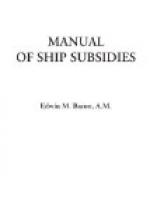Up to 1847 the British lines monopolized the transatlantic service. Then the situation became enlivened by the advent of competing American steamships subsidized by the United States Government, with high-paying mail contracts. The first of these was the New York, Havre, and Bremen line starting in 1847; the next, the celebrated Collins Line between New York and Liverpool, underway in 1850. The competing vessels were American-built, wooden side-wheelers; those of the Collins Line superior in equipment and in passenger accommodations, and faster sailers, than the British craft.[AI] To meet this competition the Cunard Company increased their fleet while the Admiralty increased the subsidy. Four new steamers were first added, in 1848, to run directly between Liverpool and New York, and the postal subsidy was raised to one hundred and forty-five thousand pounds a year for forty-four voyages—three thousand nine hundred and twenty-five pounds a voyage.[AJ] The competition began sharply with the regular running of the Collins liners, in 1850. Meanwhile during this year and the next additional contracts were given the Cunard Company for carrying the mails between Halifax, New York, and Bermuda, on the North American side, in small steamers, fitted with space for mounting an 18-pounder pivot-gun, subsidy ten thousand six hundred pounds a year; and for a monthly mail conveyance between Bermuda and St. Thomas, subsidy four thousand one hundred pounds a year.[AK] These services united the West Indies with the United States and Canada.[AK]
In 1851 John Inman entered the trade with his “Inman Line” of transatlantic screw steamers, which were to carry general cargo and emigrant passengers, then a steadily increasing business, and to be independent in all respects of either the Admiralty or the Post-Office.[AL] The unsubsidized line prospered. The next year (1852) the Cunard Company increased their liners’ horsepower, and the Admiralty again increased their subsidy. The contract, now made to run for ten years, provided a subsidy of one hundred and seventy-three thousand three hundred and forty pounds per fifty-two round trips a year. The Americans were pressing them closer. Now freight rates were cut, and the British premier is quoted as advising the Cunard Company to run without freight if necessary to “beat off the American line."[AM] The increasing subsidies occasioned a Parliamentary investigation. The committee, evidently impressed by the gravity of the American competition, reported that “the cost of the North American service was not excessive,” but they advised that all contracts thereafter “be let at public bidding."[AN] This recommendation was not heeded. In 1857, upon the plea that the Americans were about to build larger and more powerful liners, the Cunard Company asked a five years’ extension of the contract of 1852. The extension was promptly granted. At the same time they were awarded an additional subsidy of three thousand pounds for a monthly mail service between New York and Nassau in the Bahamas.[AO] The next year (1858) after suffering crushing disasters in the loss of two of their steamers, and the withdrawal of their subsidy, the Collins Company failed, and their line was abandoned.[AP] So this competition ended.




